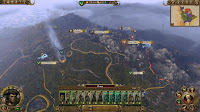I’ll
try to keep this short. Titanfall 2 is really f**king good, but it’s
far from perfect. I’ve already written a lot about what I consider
to be the weakest aspect of the title – map design – but there’s
many other issues I feel need to be addressed.
If
you’ve read my post regarding the Angel City update, you’ll know
my thoughts on the Amped Hardpoint mode and how I consider it to be
flawed not only in terms of the amp mechanic, but also in objective
placement. Many of the hardpoints need to be relocated so they are
inaccessible to titans, and the amp system should be significantly
reduced in terms of bonus.
In
my review I highlighted potential balance issues with SMG weapons.
Their effective range and damage at range needs to be seriously
reduced, whilst their bullet spread at range should be significantly
increased. Their hip fire accuracy is fine, but only if they’re
appropriately balanced as short to mid-range weapons.
There
are still issues with calling down your titan on particular maps,
resulting in it landing on the opposite side. Too many maps also have
clutter on the ground or walls that disrupt or abruptly halt your
flow of movement. The spawn system is also still a complete mess on
many maps, and the matchmaking system frequently drops you into
activate games, usually on the side that’s about to lose.
The
‘Amped Weapons’ boost is another issue and one I feel requires a
significant alteration, even though I frequently use the boost myself.
Why wouldn’t I? It transforms many of the weapons into one shot –
one kill, and also stacks over time, meaning you can play entire
matches whilst amped. An ‘amped ammo’ boost for your active
weapon would be far more balanced and would only last until the
weapon was reloaded.
Amped
Wall is another boost that’s too damn good. It not only increases
outgoing damage, but acts as an exceptional shield – an even better
shield than an actual shield boost which nobody uses as a result. An
easy fix? Let it amp shots, but remove the shield function entirely.
Reapers
and stalkers in Attrition are an irritating addition, not only as
titans often get ‘stuck’ on them, but because they reduce the
final stages of an attrition match into a reaper ‘farm’ for
maximum points. They need to be removed or massively reduced in terms
of numbers.
Melee
attacks are still hit and miss, and when you get killed by the person
you were attempting to melee it’s incredibly frustrating. On a
technical level, the servers
don’t always feel fast enough to keep up with the action. I like
the phase shift ability, but frequently get killed after entering
a shift, making the ability dangerously inconsistent.
And
inconsistency in an online
shooter is a major problem. If things don’t work the way
they should when they should, it results in a game that frequently
feels unfair. That’s a
serious issue. Because if the game doesn’t feel fair, if deaths
feel cheap and unavoidable people will simply stop playing.
Although
the developers have promised that all future maps and modes will be
free, that promise is only worth something if they actually release
something good. Or at all. I want to see more original maps, but only
if they’re unaltered, unlike Angel City. And we need new
maps that adhere to the original game’s design philosophy.
I
want to keep this short, so let’s wrap this up. Titanfall 2 is
great, but it has many issues relating to map design and balance that
must be addressed if it’s going to thrive. Many of these issues can
be fixed or improved, but only if we’re willing to call them out
and not accept the game as ‘perfect’. Because it’s not. And
I’ve seen too much nonsense online about how the game ‘deserves’
to succeed.
Bullshit.
It’s doesn’t ‘deserve’ anything. It has to earn it. There are
too many people dick riding Titanfall 2 right now and that’s not
healthy for the long term development of the title. So I can’t join
in, even though I’m a fan of the game. I want it to succeed, but
I’m not going to pretend these problems don’t exist.
I
want to be playing Titanfall 2 at this time next year, but unless the
game undergoes significant balance improvements and releases new maps
that are more appropriately designed to the strengths of Titanfall
gameplay, it’s hard to see it lasting more than another six months.
If the already dwindling player base is any indication, it probably
won’t. I hope I’m wrong.













